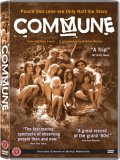| Reviews & Columns |
|
Reviews DVD TV on DVD Blu-ray 4K UHD International DVDs In Theaters Reviews by Studio Video Games Features Collector Series DVDs Easter Egg Database Interviews DVD Talk Radio Feature Articles Columns Anime Talk DVD Savant Horror DVDs The M.O.D. Squad Art House HD Talk Silent DVD
|
DVD Talk Forum |
|
|
| Resources |
|
DVD Price Search Customer Service #'s RCE Info Links |
|
Columns
|
|
|
Commune
The events of the first half of 1968 -- increasing draft resistance and student protest against the war in Vietnam, the assassinations of Martin Luther King, Jr. and Bobby Kennedy, and police killings of Black Panther Party leaders -- looked to many young people to be preludes to a civil war that would topple the existing capitalist system in the United States. In response, some young people became more militantly radicalized while others moved on to laying the groundwork for a post-capitalist system by forming cashless, cooperative communities. Jonathan Berman's documentary Commune (2005) affectionately traces the evolution of one such group through interviews with the aged founders, their children, and neighbors, and through the use of documentary records including photographs, newspaper clippings, FBI files, but especially home movies.
In the summer of 1968, Richard and Elsa Marley purchased an isolated 80-acre mining camp in the Klamath National Forest in northern California, for $22,000, for the experiment in communal living. The money was provided by James Colburn, Frank Zappa and other entertainers who were too busy using the system, to drop out of it, but who were sympathetic enough to provide the funds for others to do so. The Marleys invited all comers under the motto "free land for free people." They expected a dozen people, but forty showed up, and by that winter the number swelled to one hundred.
The commune weathered numerous challenges. A bad first winter that isolated the commune disabused everyone of the notion that communal living was carefree. In the spring, a local drug enforcement task force raided the commune, confiscating 50 marijuana plants and arresting several people. When testing revealed that the marijuana was actually tomato plants, all charges were dropped. That didn't stop the FBI from undertaking its own extended surveillance of the ranch though.
When the commune wasn't facing external challenges it was deciding internal disputes: whether the only cow should be slaughtered for meat or kept for milk (mooted when the cow slipped off a cliff and was hanged by its leash); whether monogamy was a 'bourgeois decadence' that should be prohibited (yes); whether to take in a child-worshipping cult (yes); and, subsequently, whether it was time for the cultists to be forcibly evicted (also yes).
One issue that seems to have not been a point of disagreement though was the dress code. In the numerous photographs and videotapes, clothing is a novelty, mostly limited to socks and hiking boots.
The Black Bear Ranch commune has continued through periods of growth and contraction as new members have joined and older members have departed to take work elsewhere or to raise children in nuclear families. The foreseeable future of the commune, however, is assured, thanks to a trust ownership that prohibits the sale or partition of the property, and by a large community of dedicated alum.
Beyond using interviews with founding members, their children, and neighbors, to recount the commune's history, Berman captures the coming to terms of the founding generation with mortality through the decline and passing of Richard Marley. Near the end, Marley confides that he's made peace with death, but muses "I wish I had known I was dying fifty years ago."
The DVD
The Video:
The DVD preserves the original aspect ratio of 1.66:1. Unfortunately, the disc is non-anamorphic. While a non-anamorphic presentation of a 1.66:1 feature used to be the norm because it provides a better image on traditional 4:3 televisions, there's little justification for continuing this tradition at this late date. I hope First Run Features takes note that this practice is disfavored by the viewers that care most about image quality.
The Audio:
The DVD provides a 2.0 stereo audio track which, given the surprisingly sparing use of period music in the firm, is acceptable.
The Extras:
The extras include an excellent fifteen-minute extended interview with actor, and occasional commune resident, Peter Coyote, in which he, among other things, laments not treating his body better when he was young. There's also a horrid three-minute feature of bad black-and-white video entitled "Uncensored - The 'Bare Truth' of Communal Living" consisting of footage of topless commune residents; filmmakers biographies; the original theatrical trailer; trailers for three other First Run Features DVDs; and two Mac-unfriendly DVD-ROM featurettes: the complete FBI files on the Black Bear Ranch and a collection of writings, paintings and herbal remedies entitled 'The Black Bear Family Album.'
Final Thoughts:
At an all too brief 78 minutes, Jonathan Berman barely scratches the surface of his subject matter, but what he does show about the Black Bear Ranch's past is intriguing and worthy of viewing on its own. However, Berman correctly deduces that the real story is human mortality and it's here, in the passing and remembrance of Richard Marley that this documentary really shines. Commune is recommended.
|
| Popular Reviews |
| Sponsored Links |
|
|
| Sponsored Links |
|
|
| Release List | Reviews | Shop | Newsletter | Forum | DVD Giveaways | Blu-Ray | Advertise |
|
Copyright 2024 DVDTalk.com All Rights Reserved. Legal Info, Privacy Policy, Terms of Use,
Manage Preferences,
Your Privacy Choices | |||||||














